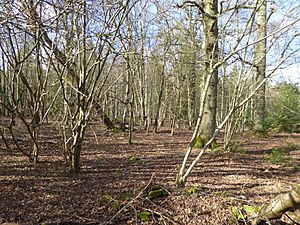Redhill Wood facts for kids
| Site of Special Scientific Interest | |
 |
|
| Area of Search | Berkshire |
|---|---|
| Interest | Biological |
| Area | 29.0 hectares (72 acres) |
| Notification | 1985 |
| Location map | Magic Map |
Redhill Wood is a very special woodland area located west of Newbury in Berkshire, England. It covers about 29 hectares, which is roughly the size of 72 football fields! This amazing place is officially known as a Site of Special Scientific Interest (SSSI) because of its important plants and animals.
Even though Redhill Wood is a protected natural site, it is on private land. This means it is not open for public visits.
Contents
Redhill Wood: A Special Place for Nature
Redhill Wood was officially recognized as a Site of Special Scientific Interest in 1985. This protection helps make sure that the unique wildlife and habitats here are kept safe for the future. It's a fantastic example of a healthy woodland ecosystem.
What is an SSSI?
An SSSI, or Site of Special Scientific Interest, is a special area in the UK. These places are protected by law because they have rare or important plants, animals, or geological features. Scientists study these sites to learn more about nature. The goal is to keep these areas healthy and full of life.
Animals of Redhill Wood
Redhill Wood is home to many different kinds of animals. These creatures play important roles in the woodland's ecosystem. They help keep the forest healthy by pollinating plants, controlling pests, and spreading seeds.
Tiny Creatures (Invertebrates)
Many of the animals found in Redhill Wood are invertebrates. Invertebrates are animals without a backbone. This group includes insects, spiders, and other small creatures. They are super important for the environment! They help break down dead leaves, pollinate flowers, and are food for bigger animals.
Some of the interesting invertebrates found here include:
- Sicus ferrugineus: A type of fly.
- Poecilobothrus nobilatatus: Another type of fly, often found near water.
- Clossiana selene: Also known as the Small Pearl-bordered Fritillary, a beautiful butterfly.
- Ectobius lapponicus: A species of cockroach, but don't worry, these are wild ones that live in forests!
Plants of Redhill Wood
The plants in Redhill Wood are just as important as the animals. They provide food and shelter for wildlife. They also help keep the air clean and the soil healthy. The wood has a mix of tall trees and smaller plants growing on the forest floor.
Amazing Trees
Trees are the backbone of any woodland. They create the habitat for many other species. Redhill Wood has a variety of tree species, showing a healthy and diverse forest.
Here are some of the trees you might find:
- Birch: Known for its papery bark.
- Fraxinus: A common woodland tree.
- Tilia: Also known as Lime trees.
- Quercus robur: The English Oak, a very strong and long-lived tree.
- Hazel: Often grows as a bush, producing tasty nuts.
- Alder: Likes wet areas, often found near streams.
- Castanea sativa: Known for its edible chestnuts.
- Salix caprea: The Goat Willow.
- Cornus sanguinea: The Dogwood, known for its red stems in winter.
- Populus tremula: Its leaves tremble in the slightest breeze.
- Sambucus nigra: Elder, which produces berries and flowers.
- Quercus petraea: The Sessile Oak, another common oak species.
Other Plants
Underneath the trees, many smaller plants thrive. These plants add to the beauty and biodiversity of the wood. They provide food for insects and other small animals.
Some of the special plants found here include:
- Paris quadrifolia: Herb Paris, a rare woodland plant.
- Sanicula europaea: Sanicle, a plant with small white flowers.
- Polygonatum multiflorum: Solomon's Seal, known for its arching stems.
- Solidago virgaurea: Goldenrod, with bright yellow flowers.
- Melampyrum pratense: Common Cow-wheat.
- Carex strigosa: A type of sedge, a grass-like plant.
- Dryopteris affinis: A common fern found in woodlands.
- Trichocolea tomentella: A type of liverwort, a small plant that likes damp places.
- Hookeria lucens: A moss with shiny, pale green leaves.
- Leucodon sciuroides: A moss that grows on tree trunks.
- Orthotrichum lyellii: Another moss species.
- Lecanactis abietina: A type of lichen, which is a mix of fungus and algae.
- Mycena clavularis: A tiny mushroom.

